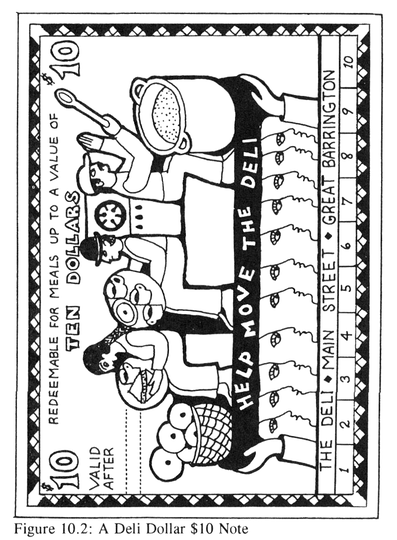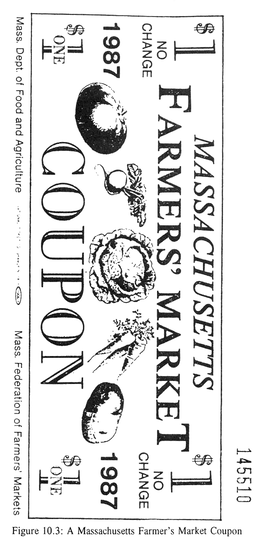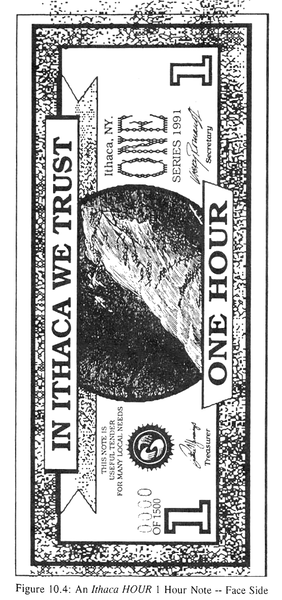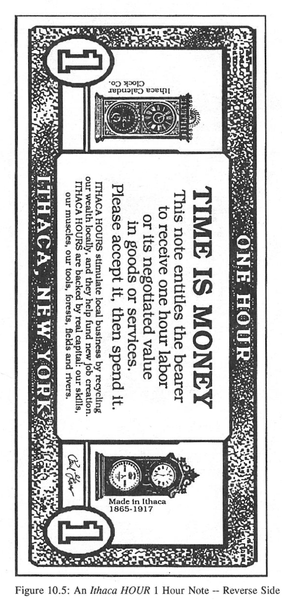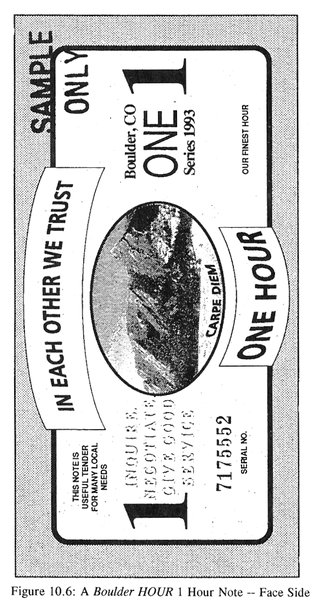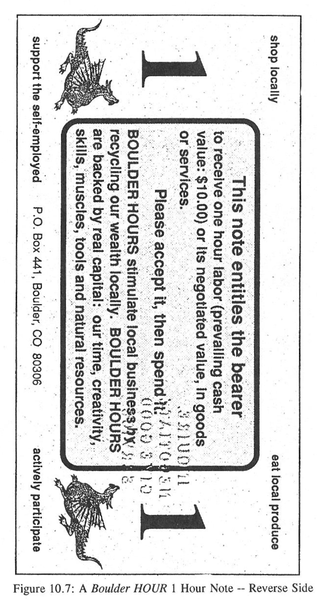"I like the idea of local people putting money directly into each others' pockets. Big industry is nothing to depend on; they're closing down and moving out. I prefer to support people I know and trust."
-- Jenny [64]
Barter, Reciprocal Trade, and Mutual Credit
In recent years there has been a proliferation of so-called "Barter" clubs and exchanges, including both non-profit clubs which serve individuals and communities, and commercial exchanges established to service business clients. For the most part, the activities of these groups do not involve barter transactions at all, but rather some form of what has come to be known as "reciprocal trade."
In common usage, the word "barter" is frequently used to describe any exchange that does not utilize official money, but this is grossly inaccurate. A barter transaction involves only two parties, each of whom has something the other wants. When party A gives item X to party B, and receives item Y from party B in return, then a complete barter transaction has taken place. If, however, one of the parties has nothing desired by the other, there can be no barter transaction. The primary role of money is to transcend the barter limitation by serving as an intermediary exchange medium.
But something other than official money may be offered as an intermediary. This can be a personal IOU which must be "made good" at some later time. More commonly, the intermediary will be a generalized IOU which a group of associated traders have agreed to honor. Such arrangements are more accurately referred to as "reciprocal trade" or "mutual credit." The distinction between reciprocal trade and mutual credit will be explained in a later chapter.
Commercial "Barter" Exchanges
"Barter" or reciprocal trade has become big business in North America, and I presume, in other parts of the industrialized world as well. There are presently in the U.S. alone, several hundred "barter" or trade exchanges. These exchanges generally operate as private incorporated businesses which collectively cater to the needs of hundred of thousands of clients, mostly small and medium sized businesses, but including many large, well-known companies. Billions of dollars of sales are mediated each year by commercial exchanges. [65]
A trade association known as the International Reciprocal Trade Association, or IRTA, was founded in 1979 "to foster the common interests of the commercial barter industry in the United States and worldwide, and to uphold high standards of ethical business practice." [66]
According to IRTA, the rapid expansion of the barter industry is due to several factors, including:
- The availability of computers which facilitate the accounting and
tracking of barter transactions.
- The growing appeal of cashless trading among business owners and
professionals because it allows them to:
- generate extra sales, thus reducing unit costs,
- open up new outlets for disposing of excess inventory,
- conserve their cash for essential expenditures. [67]
- How Trade Exchanges Operate
Barter exchanges generally charge their members several hundred dollars to join, plus an annual membership fee. In addition, they charge a commission, often 10% to 15%, on the gross value of each transaction. Membership fees are generally payable in official currency, but commissions may be payable in trade credits.
Trade exchanges perform two basic functions for their members. They act first of all as a clearing house, keeping accounts of members' transactions and trade balances, and secondly, they actively stimulate trading by brokering merchandise, either finding buyers for members' merchandise or buying it for their own account for later sale.
The contract between the trade exchange and its members specifies the respective responsibilities of each party. As part of the agreement, trade dollars are issued by a trade exchange by making loans to its members. Each member will have a particular "line of credit" (in trade dollars) which defines the maximum negative (debit) balance which that member is allowed to carry. Thus, a trade or "barter" exchange, in effect, issues its own currency, not in the form of circulating notes, but as accounting debits and credits. The amount loaned to each member must, of course, be based upon the credit-worthiness of that member, which is largely dependent upon the demand for his goods or services. This process is very similar to the way in which banks create conventional money.
The accounting unit used in exchange transactions is the "trade dollar." When a member sells services of merchandise to another member, his account is credited for the fair market value, in dollars, of the merchandise, while the buying member's account is debited (reduced) by a corresponding amount, not considering commission charges levied by the trade exchange.
In general, trade exchange operators have the power to borrow trade credits for their own account. In the past, some trade exchange operators have abused this power, spending credits in amounts well beyond their capacity to earn them through fees. As a result, the willingness of their members to sell merchandise and services for trade credits has declined, trade credits have lost their value, and the exchanges have failed. IRTA has assumed a self-regulatory function to try to alleviate such abuses and protect the industry.
- Tax Implications of Commercial Barter Trade
Barter exchange members are required to provide the exchange with their taxpayer identification number (TIN). In accordance with the Tax Equity Act of 1982, all barter transactions are recorded and the barter income of each client is reported to the IRS for tax purposes at the end of each year (using form 1099B). Income received in the form of trade credits is considered by the IRS to be taxable.
"Each barter taxpayer must include in gross income the amount of his barter income. However, the taxpayer is entitled to include barter purchases made for business purposes with his cash deductions for business expenses." [68]
LETS -- Local Employment and Trading System
LETS is an acronym which originally derived from "Local Exchange Trading System," but eventually became "Local Employment and Trading System." It is probably the best working example of a type of system which can be generically referred to as "Mutual Credit" or "Community Credit." [69] LETS was originated by Michael Linton of British Columbia, Canada, in the early 1980's. Since then, LETS systems have proliferated around the world. There are now literally hundreds of active LETS systems in various stages of development in many countries, mainly in the English-speaking world. As of late 1993, there were about 10 LETS systems in the U.S., 20 in Canada, 20 in Ireland, 120 in Britain, 60 in New Zealand, and 160 in Australia.
Recognizing the limitations and dysfunctions of the dominant national currency systems, Linton devised an approach to facilitating trade without the need for scarce official money. He realized that the fundamental characteristic of money, which allows it to facilitate exchange, is the information which it carries. He envisioned another information system which would be locally controlled and operated in parallel with the official monetary system. He designed LETS as a not-for-profit association run by and for its members. It was never intended to replace the official currency, but only to supplement it. By its nature, LETS is limited, local, and personal, and it is these characteristics which give it its strength.
A LETS system operates very much like a commercial "barter" system but it has several notable differences in philosophy, intent, and practice:
- LETS is a not-for-profit cooperative arrangement, usually unincorporated and operated by volunteers, whereas commercial "barter" exchanges are for-profit businesses.
- LETS caters to individual traders, although business members are also welcome and desired, while commercial exchanges favor large volume business clients.
- In LETS, the initiation and membership fees are nominal, sufficient only to cover the modest operating expenses of the system. Commercial exchanges charge large cash fees for membership and take a substantial percentage, usually in cash, on each transaction.
- In LETS, there is generally no interest charged on either debit or credit balances.
- While commercial exchanges actively broker trades among their members, LETS functions only as a clearinghouse and information service; there is generally no brokering of goods or services by LETS itself. [70]
Since LETS is a membership organization, LETS credits can be spent only within the membership group. This stimulates the local LETS member group to produce for its own needs and to import less from outside. Reducing imports from outside reduces the need to earn official currency. Because it is small and personal, LETS also builds community and encourages members to support one another in a variety of ways.
LETS systems typically consist of a set of accounts, usually kept on a personal computer. [71] A LETS system is like a bank in that each member has an account to which transactions are credited or debited. Like a checking account, your LETS account is credited (increased, +) when you sell something and debited (reduced, -) when you buy something. The two parties to the trade negotiate the price as they ordinarily would for a cash transaction, but, instead of using cash, the seller receives credits and the buyer is "charged" a corresponding amount as a debit.
The unit of account in the original LETS system is the "green dollar," and LETS credits are often refer to simply as "green," but each local LETS system, being independent, is free to choose any name it wants for its accounting unit. Since we are all accustomed to evaluating things in terms of the official currency, LETS uses that same value concept (dollars in the U.S., pounds in Britain, etc.) for accounting. Thus, members tend to equate the value of a "green dollar" with the value of a Federal Reserve dollar in the United States, or a Bank of Canada dollar in Canada. Unlike official dollar bank credits or cash, however, which can only be created by the banking system, LETS dollars or green dollar credits are created by LETS members themselves as needed to execute a trade. This is the crucial element which makes LETS and other mutual credit systems so empowering.
Every account begins with a balance of zero. Sales of goods or services add to one's account balance, while purchases reduce one's balance. Account balances may be negative and normally there is no interest charged on balances, though the members may agree to limit the amount of debit which a member may carry. A member with a negative or debit balance, however, is "committed" to supply that much value to others in the system at some time in the future. Having a negative balance in a LETS system is not a problem. In fact, positive balances can only exist if there are negative balances. The total of positive balances in a LETS system is always equal to the total of negative balances. Besides not charging interest on balances, there is no repayment schedule for debit balances in a LETS system. There is, however, the expectation that members with debit balances will actively offer their services to prevent their accounts being permanently in debit. Members' balances are not secret but may be made known to any other member upon request. Some LETS systems routinely publish all account balances periodically to give members a sense of the state of the system. It is still a matter of debate as to whether the published list of account balances should include members' names.
Transactions are reported to the LETS registrar or record keeper either by telephone or mail. Account balances are updated periodically and each member is sent a statement of account showing his/her transactions for the period, and his/her beginning and ending balances. In addition to the account statement, members usually receive a "noticeboard" or listing of goods and services being offered and requested. This noticeboard is actually a form of classified advertising by which members can advertise what they want and what they have to sell. Some LETS groups also publish a directory which gives more details about each members' interests, skills and needs.
As with any system, there are costs involved in the operation of LETS. Some of these are cash costs for such things as copying, postage, telephone service, etc. These are usually covered by charging an annual membership fee, and/or set-up fee in cash. Other costs, such as record-keeping, publication, management, and other services provided by LETS members are typically paid in LETS credits. These are covered by charging members, in LETS credits or green dollars, for recording transactions, printing account statements, and noticeboard advertising.
- How Does LETS Work?
To illustrate how LETS works, let's trace the steps which one might take from becoming a member to receiving her/his first statement of account. Suppose Amy wishes to join LETS-Happyville. She fills out a membership agreement and pays an initial set-up fee of $5, plus her first year's membership fee of $15. She is given a copy of the current noticeboard and directory and an instruction sheet telling how to report transactions, as well as other system procedures. Amy's account balance begins at zero.
Amy sees from the noticeboard listings that Sarah is offering automobile tune-ups, and that John is offering deep massage and acupressure treatments. She also notes that Harold wants fresh-baked, whole-wheat bread and fresh vegetables. Amy sees in each of these a potential trade. She negotiates with Sarah to have her car tuned up. They agree on a price of 30 green dollars, plus $20 in cash to cover the cost of ignition points and spark plugs. She also negotiates with John to get two acupressure treatments for a total of 40 green dollars plus $10 cash. Next, Amy sells to Harold 2 loaves of her fresh-baked bread for 5 green dollars; she also sells him an assortment of vegetables from her garden for 10 green dollars.
The cash portion of the transactions is handled by the parties to the trades. Only the green dollar amounts are reported to the LETS registrar. On the tune-up, Amy is debited 30, on the acupressure treatments she is debited 40, and on her sales to Harold she is credited 15. If this is the extent of her trading for the period, her account statement at the end of the period will show a negative or debit balance of 55 green dollars (-30 -40 + 15). There might also be system charges (additional debits) of 2 green dollars for her own noticeboard advertising and statement fee, making her ending balance a minus 57. Meanwhile, Sarah's account has been credited 30, John's has been credited 40 and Harold's has been debited 15.
There is no particular time within which Amy must clear her debit balance. She understands, however, that her debit represents her promise to the community of members. She will, in all probability, try to keep her debit balance from becoming chronic or excessive. A primary reason for making account balances public within the system is to encourage self-regulation. In such a situation, a member with a chronic or excessive debit balance may find it increasingly more difficult to find members willing to sell to her/him. By using the LETS system, Amy has "saved" $55 of hard-to-get cash on services that she needed, she has employed her friends and neighbors, and has, in effect, employed herself by providing others with the means to purchase her own goods and services. [72]
Figure 10.1, shows the creation and circulation of LETS credits. The LETS credit trading circuit conforms closely to the ideal money circuit described in Chapter 2. As in the ideal money circuit, Mr. Able creates a LETS credit when he buys something from Mr. Baker. Baker, in turn, uses it to buy something from Mr. Cook. The credit continues to circulate around until Ms. Zane uses it to buy something from Mr. Able who created it in the first place. When Mr. Able accepts it, the credit has returned to its source and ceases to exist. Of course Mr. Able can begin the process anew by buying something else for LETS credits which he can create just as he did before. Any other LETS member can do the same.
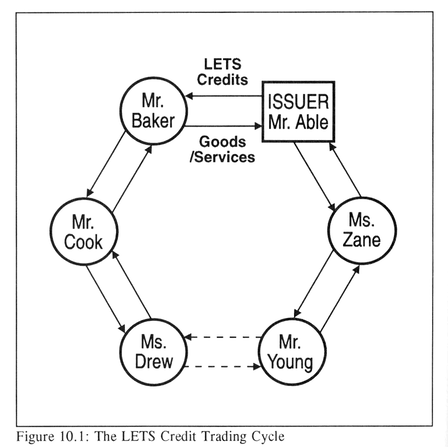
|
- LETS In Operation
Since Michael Linton introduced it in 1983, LETS has attracted considerable attention and local systems have sprung up around the world. Articles about it have appeared in magazines and major daily newspapers, and LETS has been featured on national television programs in several countries.
While LETS in the U.S. and Canada has been only a modest success, it has really taken off in other parts of the English-speaking world, notably Britain, Australia and New Zealand. The numbers of local LETS systems operating in Britain and Australia seem to be growing exponentially. New Zealand's 60 or so exchanges have thus far mediated trades worth hundreds of thousands of dollars. Its Auckland LETS system is, perhaps, the largest anywhere with over 2,000 members. [73] Australia has more LETS systems than any other country, 160 at last count, the largest being the Blue Mountains LETS near Sidney, with over 1000 members. A nationwide Australian conference in 1992 attracted 70 participants representing 40 different LETS systems. The government of the province of Western Australia has allocated $A50,000 to help launch new LETS systems in that region. [74]
In Britain, a national coordinating body called LETSLink has been established to help coordinate LETS activity and support the establishment of new systems. LETSLink has received favorable media attention which has prompted inquiries from Europe, Africa and Asia. A television documentary is being prepared for release in early 1994. [75]
In Canada, the number of LETS systems continues to grow. The Toronto LETSystem has reached a membership of over 300, and reports trading of over $200,000 since start-up. [76]
It isn't entirely clear why LETS has flourished in these other countries while languishing in the U.S. It may be that the need is greater there, and perhaps the economic and social climates are more favorable than in North America. Differing attitudes and relationships with the various taxing authorities also seem to be a factor. It seems certain, however, that as the conventional national economies continue to decline and more people become marginalized, mutual credit and local currency systems will become increasingly popular and important to the restoration of sound regional economies.
The Berkshire Experiments
A group in Massachusetts, known as SHARE (Self-help Association for a Regional Economy) has recently managed to instigate some successful local currency experiments. These have gotten quite a bit of media attention, including reports on national network television and a major article in the Washington Post, in addition to coverage in local newspapers. These experiments have consisted of at least four local currency issues -- Berkshire Farm Preserve Notes, Deli Dollars, Monterey General Store scrip and Kintaro Restaurant scrip. [77]
Each of these scrip issues has been of the same type, functioning much like gift certificates. The certificates are sold for cash, usually at a small discount, and redeemed in trade by the issuing businesses sometime later. In the meantime, they can be circulated from hand to hand as money, though there is little information available regarding the extent to which this has happened.
These experiments have been very limited in their scope, and these scrip issues, by their nature, have not provided a medium for general circulation. They have, however, been enthusiastically accepted and supported by the local community, proving the practicability of local currencies. The Farm Preserve Notes, furthermore, have received official sanction by the Massachusetts State Agriculture Department which is eager to support the state's few remaining farms. The main effect of such notes has been to provide the issuers with working capital in the off-season.
SHARE is currently working on the development of a more comprehensive scrip issue, called the "Berkshare," which will not be sold for dollars, but will be spent into circulation by members of a consortium of local businesses, each on the basis of its capacity to provide value to the community. Figures 10.2 and 10.3, respectively, show a Deli Dollar and a Massachusetts Farmer's Market Coupon.
